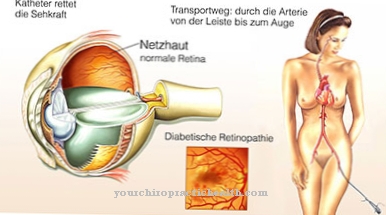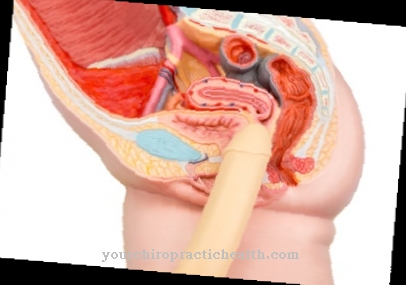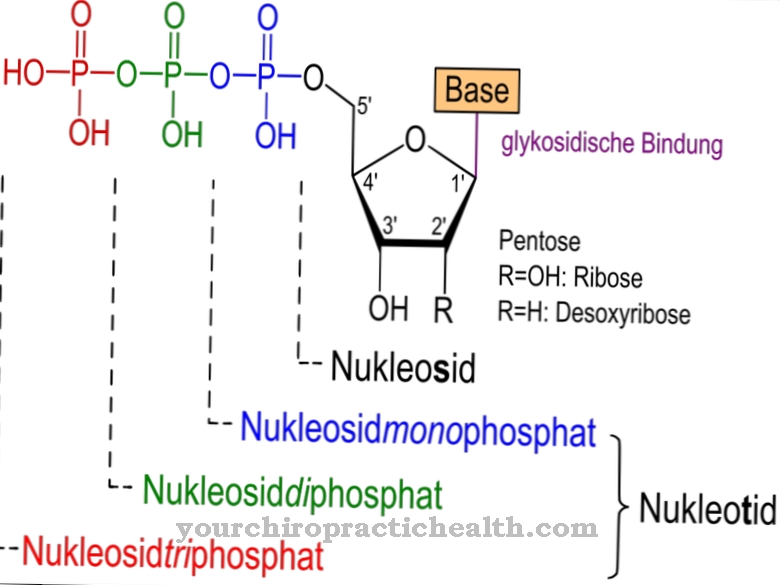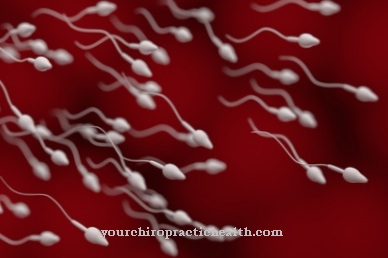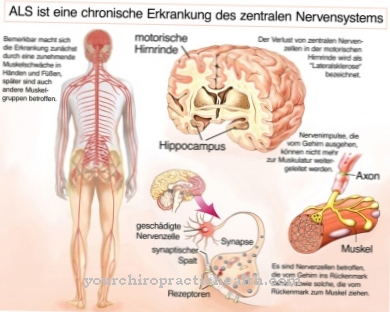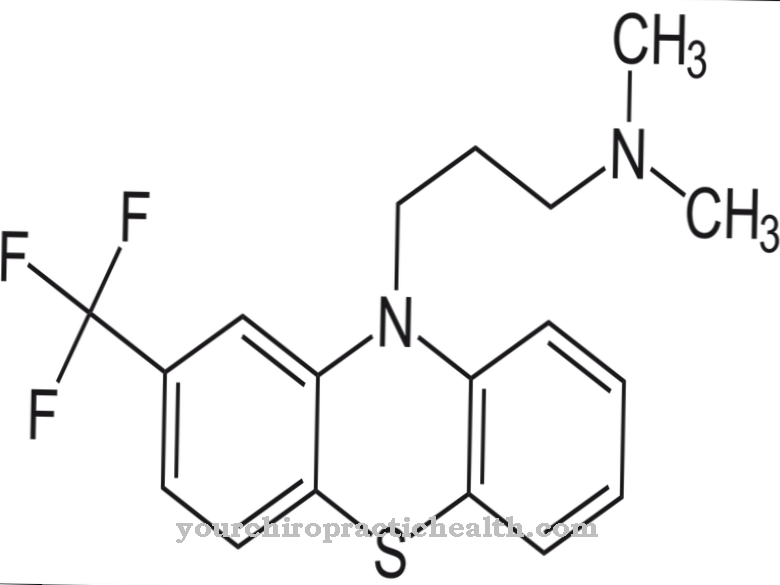In the malignant hyperthermia it is a rare but life-threatening complication of anesthesia. If there is a genetic predisposition, it is triggered by various trigger substances, including some anesthetics.
What is malignant hyperthermia?

© alfa27 - stock.adobe.com
Cause of the malignant hyperthermia is a genetic modification of receptors in skeletal muscle. Normally, skeletal muscle contracts by releasing calcium ions from the sarcoplasmic reticulum, a calcium store in skeletal muscle cells. When a muscle contraction is to be triggered, an electrical signal is transmitted to the muscle cell via the motor endplate.
Through this, a voltage-dependent ion channel is activated in the T-tubules, i.e. in special cell membrane protuberances. This ion channel is adjacent to a calcium channel of the sarcoplasmic reticulum. This in turn is called the ryanodine receptor. It will then be opened. Calcium now flows into the cytosol, which enables the myosin and actin filaments of the muscle to contract. This results in a contraction of the entire muscle.
If there is malignant hyperthermia, the above-mentioned receptors are changed due to a genetic predisposition in such a way that calcium is released in the muscle even when certain trigger substances, including narcotics, are administered. However, this is much stronger than normal. Therefore, the muscle fibers are excessively activated.
causes
This excessive activation is very critical because the released calcium has to be transported back into the sarcoplasmic reticulum. In addition, the contractile elements actin and myosin have to separate from each other again. The body needs ATP as an energy supplier for these two regenerative processes. Due to the disproportionate nature, there is quickly a lack of energy in the muscle cells.
The free calcium ions greatly increase the cell metabolism, which in turn causes an increased oxygen turnover as well as an increased production of carbon dioxide and heat. Initially, the processes mentioned take place exclusively in the skeletal muscles; in the further course, necroses and muscle breakdown occur due to the continuously deteriorating regenerative capacity.
Furthermore, harmful carbon dioxide and lactate accumulate, which cause acidification of the body. In connection with this, the body temperature rises, which in turn damages other organs. The heart muscles are primarily not affected by the pathological changes in malignant hyperthermia, but the above-mentioned processes also damage the heart in the course of the process, which can lead to death from circulatory failure.
Symptoms, ailments & signs
The clinical picture of malignant hyperthermia is characterized by a severe metabolic imbalance, especially in the skeletal muscles. The other symptoms are very different. Depending on the point in time, the clinical picture presents itself differently and not all signs always appear. Early signs of malignant hyperthermia are an increased concentration of carbon dioxide in the exhaled air and an increase in heart rate.
In addition, there may be stiff muscles, a spasm of the masseter muscle, a general lack of oxygen and over-acidification of the body. Only later does the eponymous significant rise in body temperature set in. Finally, there may be arrhythmias, a drop in blood pressure, muscle breakdown and an increased release of potassium. It is essential to pay attention to the early signs as malignant hyperthermia leads to death if no countermeasures are taken.
Diagnosis & course of disease
Because the development of malignant hyperthermia is acutely life-threatening, the diagnosis must be made as early as possible and an effective therapy initiated immediately. In any case, stopping the supply of triggering substances has priority. Inhalation anesthetics are stopped and the anesthesia is continued with intravenous medication. Normally, these do not have any triggering effect on malignant hyperthermia.
Complications
As a rule, this disease leads to a life-threatening situation that must be treated immediately by a doctor. Since this complaint usually occurs directly during anesthesia, it can also be immediately diagnosed and ultimately treated by a doctor. Those affected suffer from an increased heart rate and also from an increased concentration of carbon dioxide in the air they breathe.
Muscle rigidity also occurs and patients suffer from a lack of oxygen. The insufficient supply of oxygen to the organs can lead to serious damage to the internal organs, which are usually irreversible and can no longer be treated. In the worst case scenario, the patient will die if the complaint is not dealt with immediately. It leads to heart problems and ultimately cardiac death.
This complaint is treated with the help of medication. This alleviates the symptoms and stabilizes the circulation. In most cases, complications only arise if treatment is not started early. With successful treatment, there is no reduction in life expectancy.
When should you go to the doctor?
Malignant hyperthermia is a complication of anesthesia. It is therefore not a disease whose symptoms occur in everyday life and thus provide indications of the need for treatment. Since the patient is already under medical supervision during anesthesia, there is no need for the person concerned to act.
In addition, during this phase the patient was placed in a state of unconsciousness. It is therefore not possible for him to point out existing complaints or irregularities of the autonomic nervous system. The changes occurring within the organism are noticed by the hospital staff present and immediately forwarded to the treating doctor.
Consultation with a doctor is necessary as soon as a blood relative has been diagnosed with malignant hyperthermia within the family. Special examinations and tests should be carried out on the offspring to determine whether the disease was inherited. Before a surgical procedure, those affected with an existing genetic disposition need to consult the attending physician. He must be informed in detail about the incidents within the family and existing test results should be presented.
Therapy & Treatment
A specific drug therapy is possible through the active ingredient dantrolene. This is a substance that is administered intravenously and that inhibits the release of calcium from the sarcoplasmic reticulum. This is how the malignant hyperthermia is treated causally. At the same time, however, there is also symptomatic therapy.
This includes a stabilization of the circulatory system, a balance of the acidity of the body, a supply of electrolytes and, if available, the treatment of cardiac arrhythmias. Hyperthermia, i.e. an increase in body temperature, is a late symptom. For this reason, active cooling of the body is only necessary in the further process. Circulatory monitoring should take place at all times by means of an invasive blood pressure registration via an arterial catheter. Once the patient is stabilized, it is essential that he is monitored in the intensive care unit for some time.
You can find your medication here
➔ Medicines for painOutlook & forecast
If left untreated, malignant hyperthermia leads to a premature death of the person affected. Various complaints occur at the same time, so that in addition to serious disturbances in organic activity, an acute lack of oxygen can also be expected. For this reason, the person concerned must receive medical care as soon as possible. If there are delays or no intensive medical care, the chances of survival are extremely slim.
The prognosis improves if the circulation is stabilized immediately. Blood pressure needs to be monitored and the person concerned needs a supply of electrolytes. If there are other diseases of the cardiac rhythm system, the prognosis worsens. The diseases can lead to significant complications and also cause death of the patient. If the life-threatening condition can be averted, the affected person still has to be hospitalized for some time. His state of health must be checked daily for several weeks so that irregularities or changes can be documented.
In some cases, follow-up treatments are necessary so that the organism is adequately supplied. Nevertheless, those affected who have survived this health emergency can usually be discharged from treatment after a few months without symptoms. This is especially true if there are no other illnesses. Otherwise, the prognosis worsens and the patient must be medically monitored by a doctor over the long term.
prevention
Various measures are being taken today to prevent the development of malignant hyperthermia. For each planned anesthetic, a possible occurrence of malignant hyperthermia in the patient's family is asked in a preliminary discussion. If there is a suspicion of a corresponding predisposition, further tests are carried out at least before the planned interventions.
Two important test procedures are in the foreground: the in vitro contracture test and molecular genetic diagnostics. In the in vitro contracture test, a muscle biopsy is taken, which is then exposed to the trigger substances caffeine and halothane. If patients have a corresponding predisposition, the sample taken will contract as a result. This test is the gold standard in the diagnosis of malignant hyperthermia.
In molecular genetic diagnostics, a blood sample is taken from the patient and examined for characteristic genetic changes. This method is less complex than the in vitro contracture test. However, it is not that precise either. In summary, it can be said that the vigilance of the treating staff and prior testing of predisposition are the best options for avoiding malignant hyperthermia.
Aftercare
Malignant hyperthermia is a life-threatening situation that must be treated immediately by a doctor. The insufficient supply of oxygen can lead to severe damage to the internal organs. As a rule, the damage cannot be repaired. If the complication is not treated immediately, the person concerned usually dies quickly from the consequences.
The aftercare focuses on gently bringing the patient back to normal life. In addition to medical check-ups, which should be done regularly, it is sometimes helpful to take part in constructive conversations with loved ones in the immediate vicinity. In this way, the mental burden can be reduced a little and a self-confident handling of the experience can be promoted. If the attending doctor gives the OK, the patient can go through everyday life independently again.
You can do that yourself
In the event of an acute outbreak of malignant hyperthermia (MH) as a result of anesthesia, the patient must be treated in intensive care to prevent a fatal outcome. In this state there is no possibility for self-medication or self-help.
However, the patient has the opportunity to take preventive action in preventing an acute crisis. Since this is a genetic predisposition, the patient is obliged to inform the anesthetist in advance of an operation if there has already been a case of MH in the family. The doctor should also be aware of any muscle diseases. MH can develop in the context of various myopathies such as central core myopathy, multiminicore myopathy, periodic hypokalemic paralysis or other muscle diseases. The patient should also report to the doctor about unusual symptoms such as muscle paralysis, muscle weakness or frequent muscle stiffness in an anamnesis discussion before a necessary anesthetic. This also includes any heat strokes that you may have suffered during exercise.
For people who have already been tested, it is also advisable to present test results from an MH laboratory and, if possible, an MH ID card. The in-vitro contracture test (IVKT) is the safest method of examination. Before a test, it is urgently necessary for the patient to contact the test center in writing or by telephone in order to clarify which documents and test results must be submitted. Since the muscle sample can only be examined when it is alive and fresh, the patient must also make an appointment on site after submitting all the necessary documents.

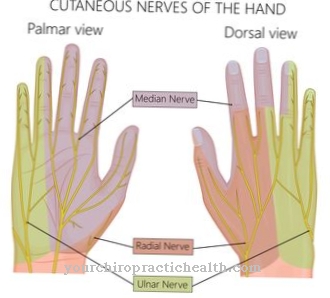

.jpg)
